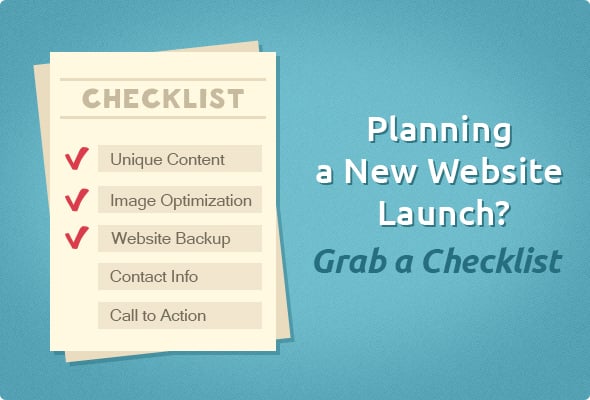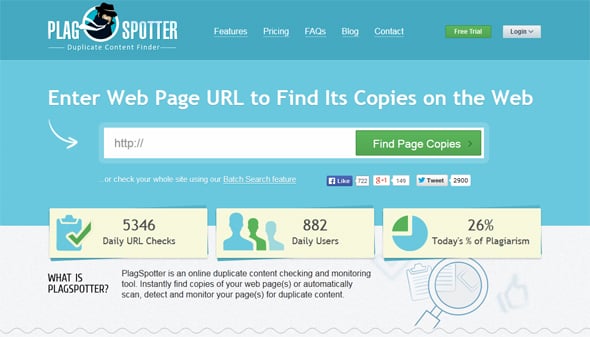It has kept you busy for weeks, if not for months. Yes, we are talking about the last stage of making a website live on the web. You need to make sure that everything is in order before a new website launch unless you don’t mind facing some embarrassing situations like Contact form is not working, links are set to hash signs and other similar issues. These issues may seem inconsequential to someone but if ignored they could adversely affect the UX and make users feel frustrated.

Here we are going to give a roundup of some issues that you should take into consideration right after your website goes online. So, without further ado, let’s get into the thick of things.
SEO Checklist
As you already know, a great looking website is not enough to secure high ranks in search engines or to drive traffic from major search engines. You need to make sure that your website is developed and designed in line with the latest guidelines released by search engines. Let’s find out how you can make your website search engine friendly.
Unique Content
Believe it or not, some webmasters do forget to replace dummy texts with original content before making the website live. Greeting visitors with ‘Lorem Ipsum’ is certainly not a great idea and therefore, you need to make sure that all dummy texts are replaced with well written and SEO-friendly content.
External Duplicate Content
You can’t use content of external websites on your website. This is a clear case of blatant copyright violation. You might be dragged into legal mess for using the copy of others without getting prior permission and if this is not enough trouble for you; your website might also get penalized by Google for having duplicate content. Google has launched Panda update to penalize websites that are using duplicate content. So, the best way to deal with this situation is by making sure that your website has only unique content. You may use the below tools to figure whether your website has original content or not.
Internal Duplicate Content
Sometimes, the same page/content of your website might be accessible or available via different paths/URLs. Though from the perspective of a user this might not be a big issue, from SEO stand point internal duplicate is an important issue to reckon with.
Check the below set of URLs to understand the situation:
http://www.example.com
http://www.example.com/index.html
http://example.com/index.html
http://example.com
All the above URLs point to the same page but they are all different URLs from the perspective of a search engine. This is where the problem of internal duplicate content comes into being. The best way to deal with this situation is by setting up canonical.
In the above example, let’s agree to set the following URL as canonical – http://www.example.com. So, you need to place the below tag within the <head></head> section of all web pages:
<link rel=”canonical” href=”http://www.example.com” />
This will fix the issue. Internal duplicate content is quite common in eCommerce websites as most products on an eCommerce website tend to be accessible via different paths. For example, a cotton yellow shirt can be accessed via the two paths:
http://www.ecommerce.com/shirt/cotton/productid=15
http://www. ecommerce.com/shirt/color/yellow/productid=15
The best way to tackle this type of situation is by setting up canonical for the preferred version.
SEO Friendly URL
URL structure is often ignored by webmasters but it can hurt the visibility of a website greatly. The first thing that you must ensure is that the URLs are meaningful. You simply can’t use random numbers or gibberish in the URL.
http://www.example.com/mobile/brand/apple/iPhone4S – [Correct URL Structure]
http://www.example.com/mob245/bx/1451rt – [Incorrect URL Structure]
The 1st URL makes more sense to both the users and the search engine bots. Make sure the URL gives the users some hints about the page content. Also it is a good practice to include some keywords or familiar phrases in the URL string as it helps get some boost in the ranking.
Dynamic URLs should be replaced with static URLs as far as possible because Static URLs give you the option to add nice structure to it. There is a myth that search engine bots can’t index Dynamic URLs but this is false. However, session ids should be avoided at any cost.
The URL length is another crucial issue that tends to plague webmasters time to time. There is no hard and fast rule but it makes sense to make it short and sweet. Google is going to truncate a long URL while featuring it on its SERP. Google advises webmasters to keep the length of the URL within 2000 characters.
Image Optimization
Since most search engine bots can’t read images efficiently, you need to use alt tag to inform the search engine bot what the image is all about. The rule of thumb is to use both keyword and descriptive words in the alt tags as it helps the images gain better online visibility.
The image file should have a proper name. File name such as ‘img01.jpg’ does not really make any sense to anyone. So, you need to use a proper name. For example, if you are using an image of a playful cat, you need to name the image file as ‘playful-cat.gif’.
Image size is another consideration that you must give utmost attention. It is unwise to use HTML/CSS to set the width and height of an image. Rather you need to use Photoshop to scale down the image. This will help you save ‘valuable’ bandwidth. There is no need to use too high resolution images. Scale down on the resolutions without making any kind of compromise on the image quality. This will help your website get loaded fast. Check out some of the most reliable online image compression tools to save time on image optimization and make sure your new website is perfect.
There is no need to use the following Meta data with raster images – ‘camera information, geo information’ etc. Feel free to remove them as you wish.
Code Errors
Sometimes even after going through the codes multiple times, you might miss out some major errors. You need to check code before a new website launch to ensure that your site does not have any junk codes in it. There are few other things that need your urgent attention and the critical among them are:
Viewport
A horizontal scroll bar is the worst thing that can happen to a website. People hate scrolling a website both horizontally and vertically. It leads to poor UX. The rule of thumb is to use Meta viewport tag to make the web pages render precisely on mobile devices:
<meta name=viewport content=”width=device-width, initial-scale=1″>
This Viewport Meta tag controls how a web page is supposed to get displayed on mobile devices. Without this Meta tag, mobile devices are going to render the web page the way it would have displayed on the desktop. Make sure you have included this tag after having some discussion with your developer.
Minify HTML, CSS & JavaScript
Sometimes, developers tend to forget to remove junk codes, comments and other things from the code. Say for example, at the initial stage, you might have agreed to run a jQuery Image gallery on a specific page but later you decided otherwise. What happens in most cases is that the developer comments out the code in JavaScript file or in some cases, the code stays there as it is. The same thing can happen with HTML, CSS files. You need to make sure that you have taken care of these issues before your new website launch.
Leverage Browser Caching
To render a web page completely, browsers need to download all the files that usually include CSS, HTML, images, JavaScript and many more. This is not a major issue when the web page is relatively light weight and the browser does not have to download large amount of data. Though the things get messy if the browser has to download heavy files. By allowing browsers to store some of the files locally, you can decrease the website loading time. This is what is known as ‘Leverage Browsing Cache’.
Gzip Compression
What Gzip does is it compresses the Style Sheet and other files before they are being sent to the web browser. As far as reports are concerned, by enabling Gzip compression, you will be able to cut down the transferred response time by 90%, which is impressive by any yardstick.
Mobile Friendliness
Since more and more people are switching between multiple devices, it makes sense that your website has a mobile version ready. Otherwise your visitors will feel disappointed to say the least. However, if your website has a mobile version ready, you need to inform the search engines about its existence otherwise they might end up serving the desktop version of the website to the mobile users and vice versa.
Avoid flash videos for the mobile version because most mobile devices don’t offer any support for flash. Try to make the mobile version load quickly by reducing the amount of graphics and other elements as far as possible.
Don’t block CSS or JavaScript file via robots.txt file because search engine bots tend to analyze them to be able to figure out whether the website is meant for the mobile devices or is built primarily for desktop devices.
To learn more SEO tactics that can help you in a new website launch, you can download our free eBook on website on-page optimization
Technical Checklist
Once you have taken care of the SEO aspect of your website, the next important stage is technical.
Website Backup
Believe it or not, some web hosting companies don’t keep backup of websites hosted on their server. Therefore, if your website ever gets hacked and you don’t have its backup, you might find yourself in the middle of nowhere. Therefore, it makes sense to keep a backup of your website regularly.
You can take a backup of your website via an FTP client like Filezilla but the problem with it is that you can’t skip the process once it is started and it takes long time to get completed especially if your website is large. This method is ideal for websites with less than 10 pages. Don’t forget to take a backup of your website’s database too.
You can create a backup of your website if login into the cPanel provided by most web hosting companies. All you need to do is to login to your cPanel account and look for the download option and then generate a website backup. Keep that backup in a safe place and if possible keep that backup on multiple places.
Website Security
Hackers are always trying to break into websites to insert malicious codes to them and that means, if you are not careful enough, the security of your website might get compromised. There are few things that you can do to safeguard your website from external attacks:
You need to make sure whatever software or applications you are using are up to date. Hackers aggressively target security flaws in software or CMS. Therefore, it makes sense to use latest version of software and applications as they offer better and more robust security features.
Also you need to use strong passwords that should contain upper case, lower case, special characters and numbers so that hackers can’t hack into your website easily. Your PC should be cleaned with a trusted anti-virus. Otherwise your website might get infected with virus when you will be trying to upload files via FTP.
Conversion Checklist
Safeguarding your website from malicious attacks is not the end of the job. If your website is not user- and conversion-friendly, no one is going to buy the service or product that you are trying to promote. Here are some aspects that you need to take a look at:
Contact Details Placement
The Contact Details of your website need to be placed prominently either on the header section or the footer section of your website so that people can contact you without any hassle. A separate Contact Us page is a necessity these days. It is a good practice to include physical address of your business in the Contact Us page as it assures the users that you don’t have anything to hide.
Call to Action
You need to use texts or buttons that encourage people to take certain actions, otherwise people might get confused about what to do next. For example, if you are an owner of an eCommerce website, you need to make sure that the ‘Buy Now’ button is prominent enough to capture the attention of the users at the very first sight. In other way, you are going to see a massive decline in the conversion rate.
Unique Selling Proposition
Just the placement of calls to action is not going to change anything. You need to make sure that you have highlighted the unique selling sroposition (USP) of the product or the company. You need to make people aware what makes your product different from others. You may use bullet points or bold texts to seize the attention.
So, these are some tips that you should give a try once your website is live.

